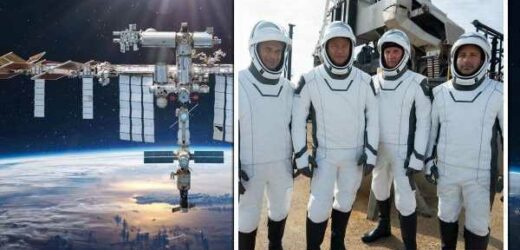NASA spot 'glowing object' near International Space Station
We use your sign-up to provide content in ways you’ve consented to and to improve our understanding of you. This may include adverts from us and 3rd parties based on our understanding. You can unsubscribe at any time. More info
The hazardous debris field was generated when Russia conducted its first field test of an A-235 Nudol anti-satellite (ASAT) missile on its inactive Kosmos-1408 electronic signals intelligence satellite on November 15 last year. The craft exploded into at least 1,500 pieces of debris that can be tracked by ground-based radar — although it is possible that there are hundreds of thousands more. The shrapnel is presently maintaining orbits between 190–680 miles above the Earth’s surface.
In the immediate aftermath of the explosion, the crew of the ISS were forced to take shelter in their escape capsules for the orbiting laboratory’s first few passes of the debris cloud.
In response, US Secretary of State Antony Blinken said: “The long-lived debris created by this dangerous and irresponsible test will now threaten satellites and other space objects that are vital to all nations’ security, economic, and scientific interests for decades to come.”
US State Department spokesperson Ned Price added: “Russia’s dangerous and irresponsible behaviour jeopardises the long-term sustainability of outer space.
He added that the incident “clearly demonstrates that Russia’s claims of opposing the weaponization of space are disingenuous and hypocritical.”


The debris — which is expected to remain in orbit for years, if not decades — continues to interfere with planned ISS operations.
Two weeks following the weapons test, NASA was forced to delay a planned spacewalk amid concerns that the astronauts might be at risk exposed outside the station’s shell.
The latest manoeuvre to avoid the debris saw the engines of the docked Progress MS-18 transporter fired for around 10 minutes on Saturday, as to raise the ISS’s orbital altitude by around 1.1 miles — bringing it up to 257 miles above the Earth’s surface.
According to CBS space news reporter William Harwood, the so-called “reboot manoeuvre” planned on Friday also had a purpose beyond avoiding a “possible close encounter” with a piece of debris from Kosmos-1408.
This, he tweeted, was to “improve downstream trajectory planning.”
Fortunately, the emergency boost did not further delay Axiom Space’s private Ax-1 mission’s departure from the ISS in a SpaceX Crew Dragon capsule.
Their return to Earth was put on hold for a number of days due to bad weather on the Florida coast.
The four-person mission included former NASA astronaut Michael López-Alegría along with three paying customers – US real estate entrepreneur Larry Connor, Canadian businessman Mark Pathy and Israeli philanthropist and former fighter pilot Eytan Stibbe.


The latest in the fallout from Russia’s ill-advised anti-satellite weapons test comes as researchers from the University of Edinburgh have called for the space’s “fragile environment” to be given the same kind of special legal protection afforded to Earth’s land, atmosphere and seas.
The team — who published their recommendations in the journal Nature Astronomy — pointed not only to the risk from space debris, but also to the increasing congestion of Earth’s orbit by so-called satellite mega-constellations like Elon Musk’s Starlink.
Not only does this make low-Earth orbit an inherently more dangerous place, the researchers warned, but the satellites are also adding to light pollution which both spoils the appearance of the night sky and interferes with astronomical observations of the universe.
The team has called for policymakers around the globe to work together to create a “shared, ethical and sustainable” approach to space.
DON’T MISS:
Study reveals risk of heart problems after Moderna or Pfizer vaccines [ANALYSIS]
Musk and Bezos have UK space sector ‘on their radar’ [INSIGHT]
Hepatitis warning as cases in children in UK surge [REPORT]

Astronomer Professor Andy Lawrence of the University of Edinburgh said: “We are standing on a watershed in history.
“We can cheaply launch huge numbers of satellites and use them to the benefit of life on Earth – but this comes at a cost.
“As well as damaging stargazing, the space industry may be shooting itself in the foot.”
His colleague Professor Moriba Jah — an aerospace engineer at The University of Texas at Austin — added: “We believe that all things are interconnected and that we must embrace stewardship as if our lives depended on it.
“Traditional ecological knowledge holds a key to solving this wicked problem.
“The largest challenge we have is in recruiting empathy and compassion toward solving these environmental crises.
“If we can find innovative ways to enable the general public to project themselves into this dire condition, and feel concern to address it, the earth, and all of the lives she sustains, wins.”
Source: Read Full Article


